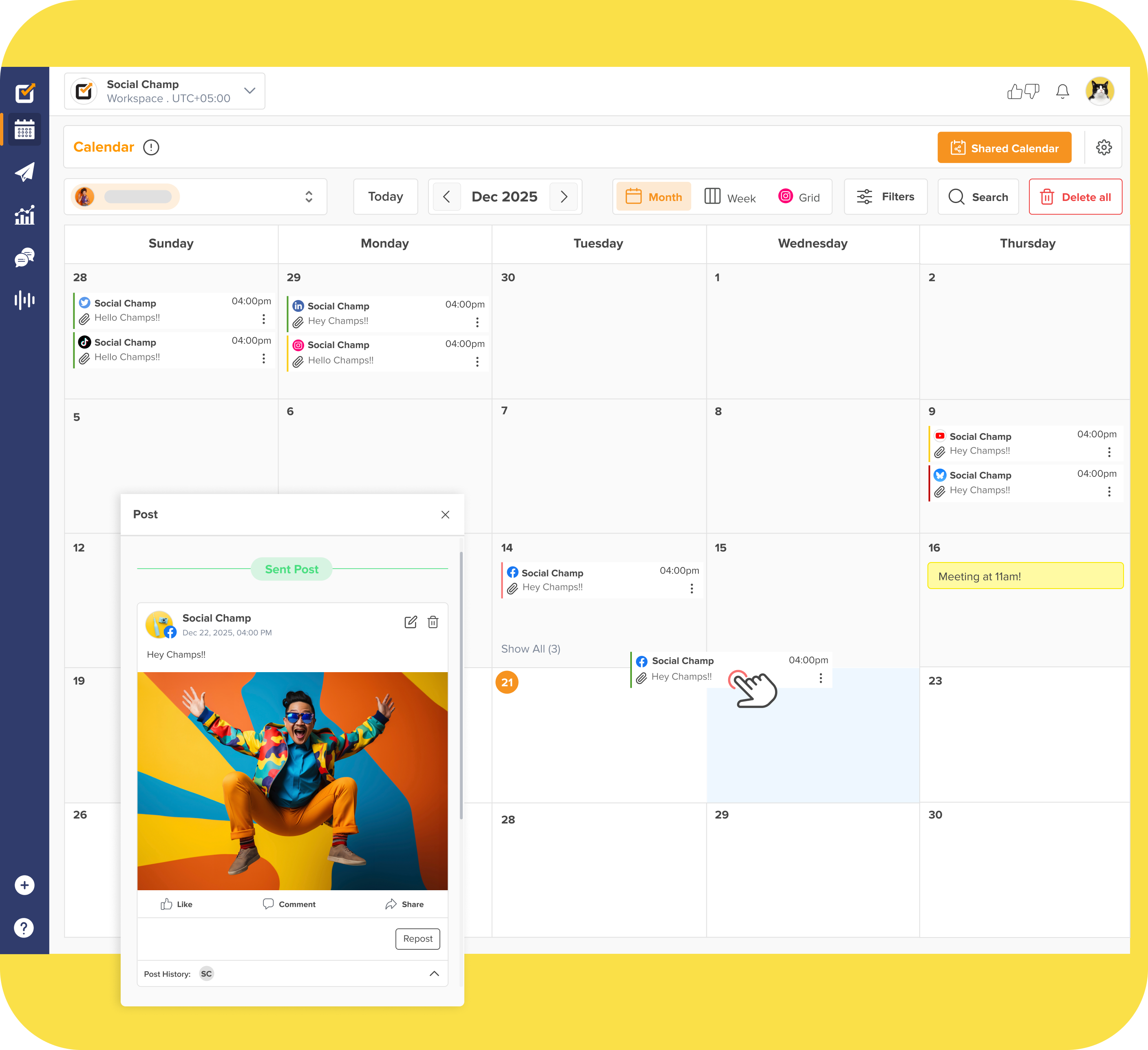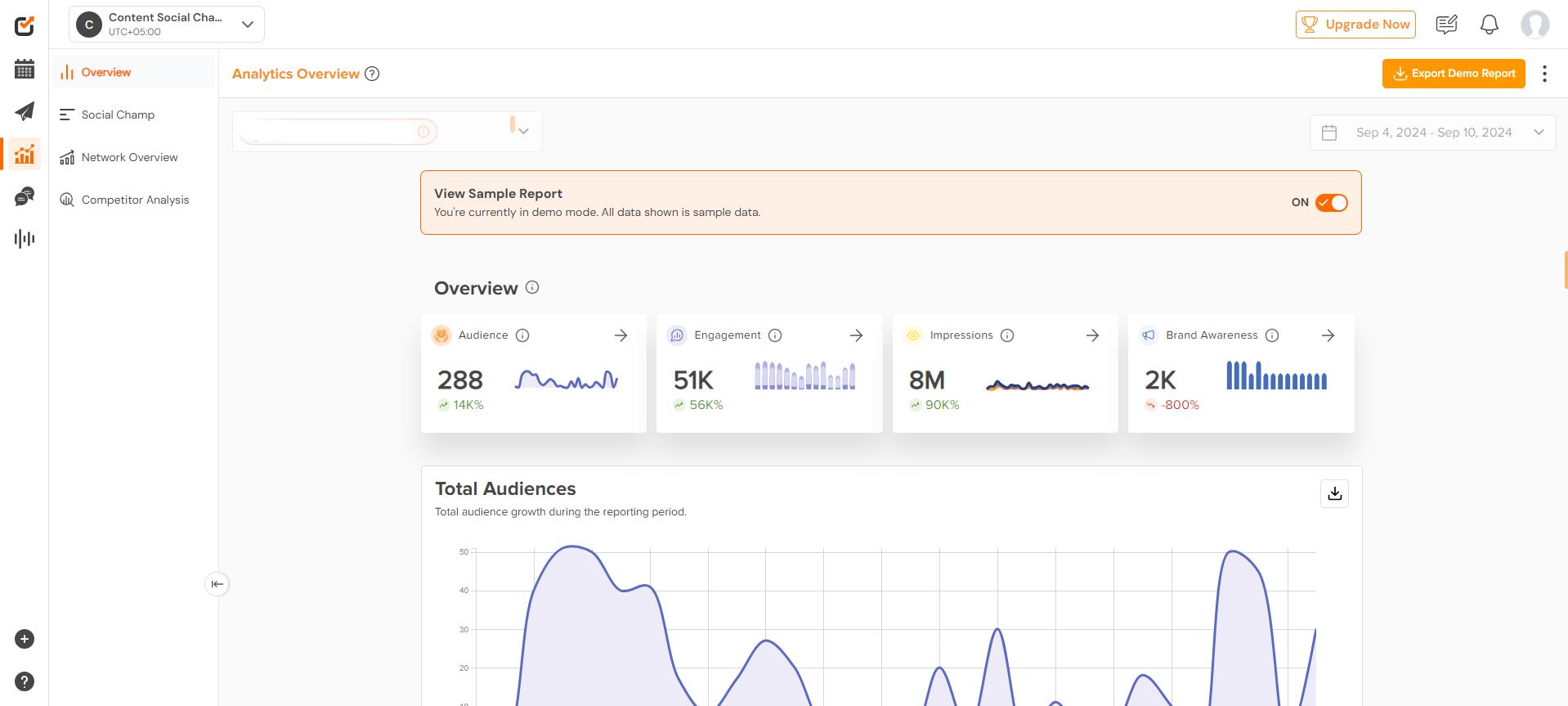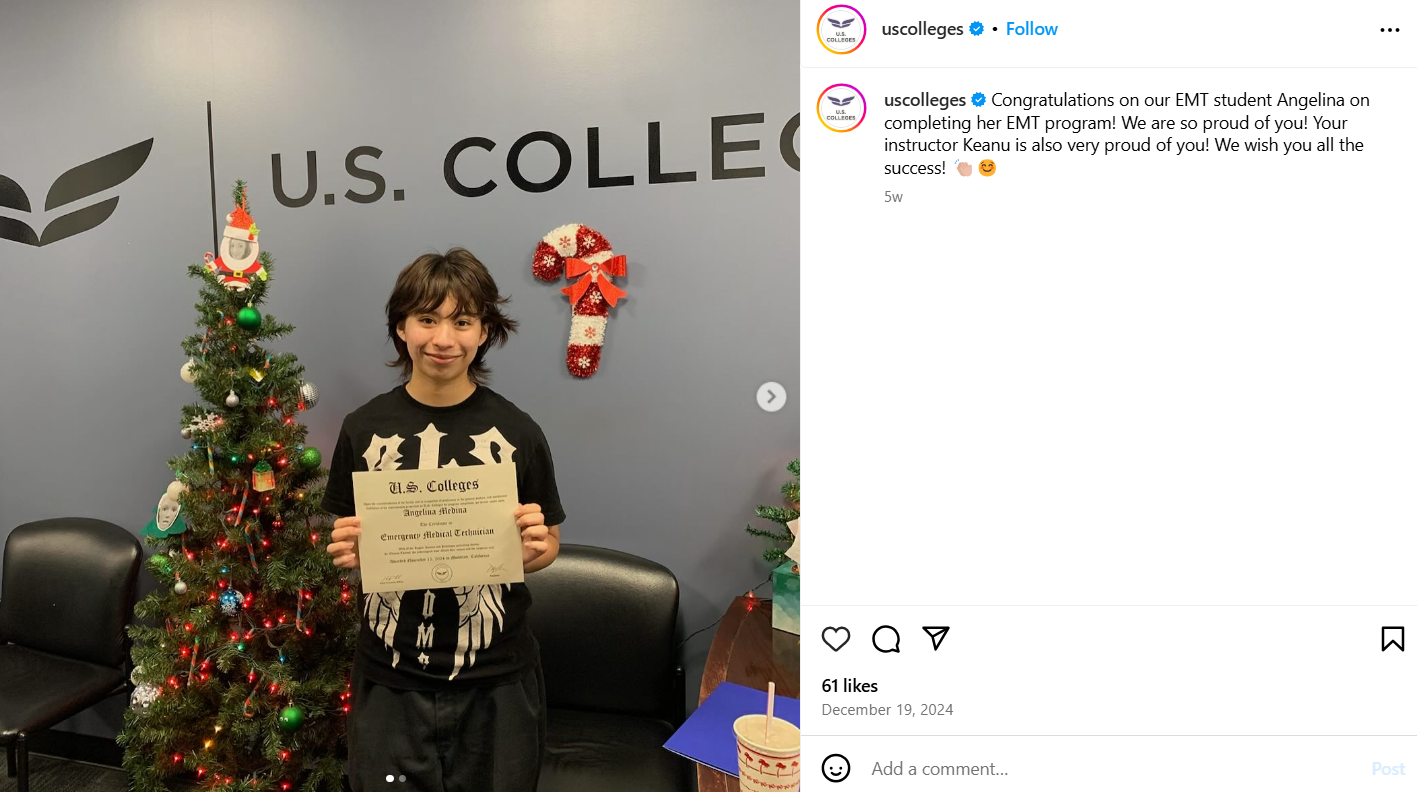Whether you’re in school administration, college admissions, or ed-tech, social media marketing for educational institutions is now essential for communication, branding, and engagement.
With 82% having a presence on at least one social media platform, this game is all about smarter strategies, streamlined tools, and meaningful connections.
Social media platforms like Facebook and Instagram now serve as virtual campuses—spaces where prospective students, parents, and even alumni gather, converse, and decide.
This guide unpacks practical, cutting-edge strategies to elevate your social media presence with ease.
From crafting engaging content calendars to leveraging social media analytics and yes, embracing the power of social media management tools, we’ll show you how to use social media for education.
Let’s dive in!

Don’t Let Your Institution Fall Behind!
With Social Champ, streamline your campaigns, schedule posts effortlessly, and analyze performance to stay ahead in the education game.
Short Summary
- Social media is a crucial tool for educational institutions, enhancing communication, branding, and engagement.
- 82% of institutes are on at least one social media platform, highlighting the importance of smart strategies and tools.
- Higher education social media has become a virtual campus for students, parents, and alumni to engage, explore, and make decisions.
- Social media marketing strategies are now essential for building trust, reaching targeted audiences, and driving enrollment.
- Effective social media strategies should include clear goals, audience understanding, consistent branding, and regular engagement.
- Social media management tools like Social Champ simplify scheduling, boost audience engagement, and offer actionable insights.
- Best practices include focusing on quality content, using hashtags strategically, embracing storytelling, and maintaining a consistent posting schedule.
- Measuring success through KPIs, analytics, and feedback is key to refining strategies and achieving educational goals.
- Consistency, creativity, and adaptability are essential to staying ahead for social media teams in the digital landscape and driving success for educational institutions.
The Importance of Social Media Marketing for Educational Institutions
Gone are the days when glossy brochures and static websites were enough to attract students and engage parents.
Today, prospective learners and their families turn to platforms like Instagram, LinkedIn, and TikTok to explore campus culture, academic programs, and student life.
Digital marketing is not just about visibility; it’s about building trust and community.
Social media for higher education connects institutions with stakeholders by showcasing teaching innovations, celebrating student achievements, and promoting events.
Moreover, with targeted campaigns and analytics, educational institutions can reach precisely the right audience.
By understanding who engages with their content, they can refine their messaging and improve enrollment rates.
In short, effective higher education marketing is no longer optional—it’s the cornerstone of modern education strategy.
Featured Article: Top 10 Social Media Management Suites in 2025
Developing an Effective Social Media Strategy for educational institutions
Educational institutions, including colleges and universities, must craft strategies that reflect their unique culture while addressing the needs of prospective students, current learners, alumni, and parents.
Here’s how to build a winning approach:
-
Define Clear Goals
Start with a purpose. Whether it’s increasing enrollment, enhancing community engagement, or boosting event attendance, your strategy should align with your institution’s overall mission.
-
Understand Your Audience
Dive deep into who you’re trying to reach. High schoolers exploring colleges might be on TikTok, while parents may prefer Facebook.
Tailoring your content to fit these preferences ensures relevance and impact to attract prospective students.
-
Showcase Your Strengths
Every institution has a story to tell. Highlight unique programs, student achievements, faculty expertise, and campus life.
Authentic, relatable content builds trust and fosters interest.

Instagram Post by @nyuniversity’s Announcing New Semester -
Use Consistent Branding
From your logo to your tone of voice, consistency is key. This helps create a cohesive digital presence that’s easily recognizable and reflects your values.

@tristar.education’s Instagram Profile -
Engage, Don’t Just Broadcast
Social media in education is a two-way street. Respond to comments, join conversations, and ask questions. The more you engage, the more connected your audience feels.
-
Leverage Analytics and Tools
Social media management platforms like Social Champ can simplify the process. Use them to schedule posts, track engagement, and refine your strategy based on data-driven insights.

Social Champ’s Analytics
Leveraging Social Media Management Tools
Managing multiple social media platforms can feel overwhelming, especially for higher education institutions juggling busy schedules and diverse audiences.
This is where the use of social media in education become game-changers, offering a streamlined way to stay organized, consistent, and impactful.
-
Simplify Scheduling and Posting
Managing social media for educational institutions can be overwhelming, especially during busy times like admissions or exam periods.
However, platforms like Social Champ allow you to plan and schedule posts in advance across multiple social media channels, ensuring your content calendar remains active without the constant need to post manually.
By planning ahead, you can maintain a consistent online presence for students and parents even when your team is busy with other tasks.
-
Boost Audience Engagement
Engaging with your audience is a key part of building relationships on social media for current students, but managing comments, messages, and mentions across various platforms can quickly become a time-consuming task.
Social media management tools offer centralized dashboards that make monitoring and responding to interactions easier and faster.
Instead of logging into multiple platforms to reply to questions or acknowledge feedback, you can manage it all from one place.
This not only saves time but also ensures that your responses are timely and that your audience feels valued.
-
Gain Actionable Insights
Understanding what’s working—and what isn’t—is essential for refining your social strategy.
Social media management tools provide in-depth analytics that track the performance of each post or campaign.
From engagement rates to click-throughs, these insights help you understand which types of content resonate most with your audience.
Are your student success stories garnering more attention than event promotions?
Is a particular hashtag driving more traffic to your page?
With this data, you can refine your strategy to boost reach, improve engagement, and drive your institution’s goals, whether it’s increasing applications or enhancing community involvement.
-
Maintain Consistency
Consistency is the foundation of strong social media benchmarks.
Regular, well-timed posts ensure your audience knows when to expect updates and helps build a recognizable brand identity.
For educational institutions, this means sharing everything from campus updates to student achievements, faculty highlights, and important events.
Social media management tools like Social Champ allow you to schedule posts in advance, creating a consistent flow of content without needing to manually post every day.
-
Collaborate Seamlessly
For larger educational teams, social media management tools simplify collaboration and ensure content remains cohesive across different departments and platforms.
These tools allow social team members to assign roles, review content before posting, and provide feedback in real-time.
Whether it’s the admissions team scheduling a post about application deadlines or the marketing team preparing a campaign for an upcoming event, these tools enable everyone to stay on the same page.

Your Students Are Social, But Is Your Campus?
Transform your institute into a digital powerhouse! With Social Champ, schedule, analyze, and amplify your social media presence effortlessly.
Implementing Social Media Best Practices
Educational institutions can use the following strategies to connect authentically with their audience and stand out in the crowded digital space.
-
Focus on Quality Over Quantity
In the fast-paced world of social content, it can be tempting to post constantly to stay top-of-mind. However, quality should always take precedence over sheer frequency.
Content that is polished, visually appealing, and relevant to your audience helps build trust and credibility.
Posts with high-quality images, videos, or well-crafted text resonate more with followers than generic or rushed content.
Educational institutions can enhance their brand reputation by sharing carefully curated content that aligns with their mission and values.
Check out this video by @americanuniversity showcasing how they have changed over the years!
-
Use Hashtags Strategically
Hashtags are essential for increasing the visibility of your social media content, allowing posts to be discovered by users outside your current follower base.
When using hashtags, balance trending or general ones for higher education (like #HigherEd or #CampusLife) with institution-specific tags (such as #FutureLeadersAt[YourSchool]) to create a unique identity for your institution.
The key is to avoid overstuffing posts with too many hashtags—opt for a few highly relevant and impactful ones that amplify your message.
-
Measure and Adapt
Social media marketing for educational institutions isn’t a set-it-and-forget-it endeavor. To truly succeed, you must constantly assess how your posts are performing.
This involves tracking metrics like engagement rates (likes, shares, comments), click-through rates, and conversion rates (such as form submissions or applications).
With tools like Social Champ, you can easily monitor the performance of each post, helping you understand which types of content resonate best with your audience.
By analyzing this data, you can adjust your strategy in real-time—experimenting with different content formats, posting times, and messaging to maximize engagement and effectiveness.
-
Embrace Storytelling
People are naturally drawn to stories, and when it comes to social media, storytelling humanizes your institution and makes it more relatable.
Share stories about your students, faculty, and alumni—whether it’s a student’s journey from freshman year to graduation or a professor’s groundbreaking research.
Behind-the-scenes glimpses into higher education campus life, events, or community service projects also help portray your institution as more than just a place to study—it becomes a place where people thrive and grow.
Storytelling builds emotional connections with your audience, turning them into loyal followers, potential students, or enthusiastic advocates for your institution.

Instagram Post by @uscolleges’ Congratulating a Student -
Maintain a Schedule
Consistency in posting is essential for keeping your audience engaged and anticipating what’s next.
A well-maintained posting schedule ensures that your institution remains active on social media without overwhelming your team.
By establishing a rhythm for your posts—whether it’s weekly updates, monthly highlights, or daily tips—you maintain a steady presence that strengthens your connection with followers.
Featured Article: TikTok Business Center: The Ultimate Guide for 2025
Measuring Success and Adapting Your Strategy
Here’s how to measure success effectively and continuously improve:
-
Set Clear KPIs
Key Performance Indicators (KPIs) are the foundation of measuring success.
Whether it’s engagement rates, website traffic, or the number of applications submitted, defining clear objectives helps focus your efforts. Common KPIs for educational institutions include:
- Engagement Rate (likes, shares, comments)
- Click-Through Rate (CTR) for links to events, programs, or admissions pages
- Follower Growth on your social media accounts
- Conversions, such as form submissions or application completions
-
Use Analytics Tools
Most social media platforms have built-in analytics tools, but third-party management platforms like Social Champ offer even deeper insights.
Track post performance, understand your audience demographics, and monitor which types of content generate the most interest. This data will allow you to fine-tune your campaigns.

Be the Campus Everyone’s Watching (and Engaging With)!
With Social Champ’s powerful analytics, discover what clicks, what sticks, and what gets shared. Turn insights into impact.
-
Analyze Content Performance
Review which types of content—videos, images, blog links, etc.—drive the most engagement.
Did a particular success story go viral?
Is a video tour of your campus resonating with prospective students?
Knowing which content performs best helps you replicate those strategies in the future.
-
Monitor Competitor Activity
Keep an eye on what other educational institutions are doing. Identify what strategies they’re using successfully and adapt them to fit your unique brand and goals.
It’s not about copying; it’s about understanding trends and refining your approach.
-
Gather Feedback
Engagement is a two-way conversation.
Ask your audience for feedback on what they find helpful or interesting. Polls, surveys, or direct responses to comments can give you valuable insights into their preferences.
-
Adjust Based on Data
Don’t be afraid to pivot. If a particular strategy isn’t yielding results, tweak your approach.
Maybe your audience prefers more behind-the-scenes content or more academic-focused posts.
Constantly adapt based on performance data to ensure you’re meeting your goals.
Conclusion
As we move into 2025, social media has become an indispensable tool for educational institutions looking to build stronger connections, increase engagement, and drive success.
The key to success lies in consistency, creativity, and adaptability.
Whether you’re just starting to build your social media presence as a marketer or refining an existing strategy by using user-generated content, the possibilities are endless.
Don’t let the fast-paced digital world leave you behind—embrace these strategies, measure your progress, and stay ahead of the curve.









